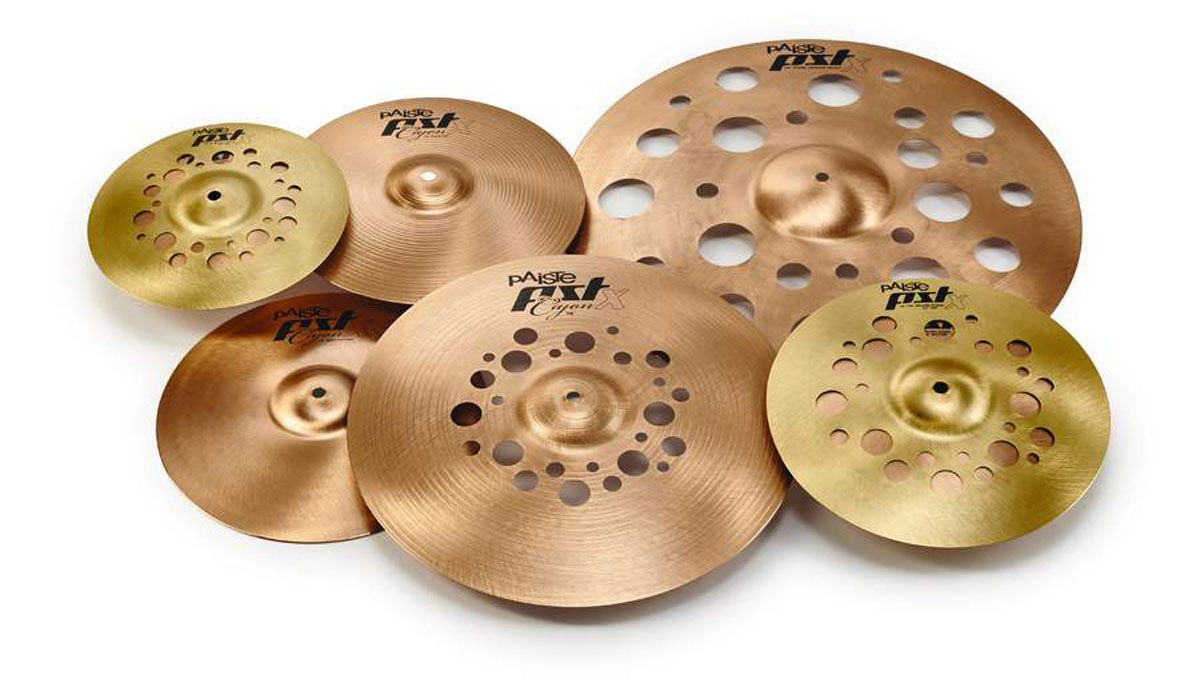MusicRadar Verdict
The variety of sounds and textures from these new models means their appeal is not limited to any one type of player. They make inspiring and affordable additions to many set-ups whilst benefiting from Paiste’s legendary consistency.
Pros
- +
A great range of cymbals.
Cons
- -
Some may be an acquired taste.
MusicRadar's got your back
Paiste’s customary unveiling of new models at January’s NAMM show included additions to its PST X series.
Launched in 2015 under the banner ‘Unlimited Noise For Limited Budgets’, the range consists almost exclusively of effects and specialist cymbals. Along with more typical trashy offerings, the new models also include dedicated Cajon cymbals.
Build
Something of an outlet for the more eye-catching and ear-shredding concepts that Paiste’s Sound Development team have dreamt up, PST X cymbals feature lesser-used alloys, such as aluminium and brass, as well as conventional bronze.
In keeping with their affordable status, PST X cymbals are manufactured in Switzerland through a method that Paiste describes as hybrid technology – ‘a combination of modern innovative methods and traditional hand craftsmanship’.
With the exception of one model (the Cajon Hats), all the new cymbals feature holes - and plenty of them - in various sizes and combinations. Two all-new Splash Stacks in diameters of 10"/8" and 12"/10" join the only existing PST X stack, the Flanger Stack. Unlike the Flanger Stack, which piggybacks its pair of cymbals the same way around, the Splash Stacks are mounted more in the manner of hi-hats so only the edges make contact (in fact, the edge of the bottom cymbal touches the bow of the top cymbal due to size difference).
PST X cymbals are manufactured in Switzerland through a method that Paiste describes as hybrid technology
The larger top cymbal is brass while the smaller bottom is made from 2002 bronze and sports an inverted bell. Holes are dotted around the mid-portion of the top cymbal while its bronze brother below is perforation-free. The two new models designed for accompanying a cajon are a pair of 12" hats and a 16" crash/all-rounder.
Cajons are increasingly popular in busking and unplugged environments and Paiste already markets cajon-specific cymbals (within its PST 8 series); the new PST X models provide ‘an improved response and a wider range of dynamics’. Both models are made from 2002 bronze and share the same brushed finish. A 20" Swiss Medium crash joins an established 18" model and is also made from 2002 bronze. The name Swiss is doubly apt as it not only alludes to the cymbal’s place of manufacture, but also to Switzerland’s famously hole-ridden Emmental cheese. And holes certainly are a feature... notwithstanding the obvious characteristics that so many holes impart, the fine brushed finish gives the Swiss Medium a slightly deceptive air of refinement.
Hands on
Setting the Splash Stacks up requires a cymbal stand with a generous threaded top and felts that err on the slender side due to the gap between the two components, despite the inverted bell of the bottom cymbal. Once in place they waste little time in delivering short, sharp slices of trashiness.
Somewhere between a choked splash and a processed hi-hat sound - albeit with their own individual twist - they reward pretty much any kind of sticking, from single or multiple accents through to patterns and beats. Tightening them down chokes the already instant decay even further; loosening them off finds a pleasing after buzz remaining for a few nanoseconds after the main note, but these type of cymbals are all about the whiplash-quick response. Choosing a favourite is difficult as both pairs work together really well, particularly for hand-to-hand patterns and accented fills.
With their 12" diameter the Cajon Hats are suitably quick and bright, though there is a smoothness to the top-end that gives them a pleasantly rounded note. They have been designed for acoustic situations and dynamically they fit the bill, projecting well without being overly assertive. Relaxing the pedal finds their response widening to a soft blur and stepping gives a feathery ‘chick’.
In a world of beta cymbals this is very much an alpha male - aggressive and dominating in any situation
The accompanying 16" Cajon crash can be played with either sticks or hands. It sparkles with brightness, decays quickly when crashed and gives a clear - if fairly toppy - stick sound when ridden. The pattern of holes clustered around the bell brings a delicate spicing of trashiness. It’s a subtle cymbal but one that is surprisingly versatile. Moving up to the 20" Swiss Medium finds any subtlety blasted out of the window.
Combining the tonal attributes of a China and the playing characteristics of a big crash, what it lacks in manners it makes up for in sheer presence. Played tentatively, it almost hisses with menace, revealing a discordant note and fizzing decay. Crashing tears a hole in the backline while shouldering the bell is enough to rouse sleeping firefighters in the next town.
In a world of beta cymbals this is very much an alpha male - aggressive and dominating in any situation. While it is undoubtedly loud, its performance is not just down to the volume it’s capable of - the frequencies it produces play as big a part. It’s a brute of a crash, as abrasive as a squaddies’ night out and, without hearing protection, a guaranteed fastrack to tinnitus.
“Instead of labouring over a perfect recreation, we decided to make an expanded counterpart”: Chase Bliss teams up with Mike Piera for Analog Man collab based on the legendary King Of Tone
“It’s about delivering the most in-demand mods straight from the factory”: Fender hot-rods itself as the Player II Modified Series rolls out the upgrades – and it got IDLES to demo them
“For some reason, the post office shipped your guitar to Jim Root of Slipknot”: Sweetwater mailed a metal fan's Jackson guitar to a metal legend










